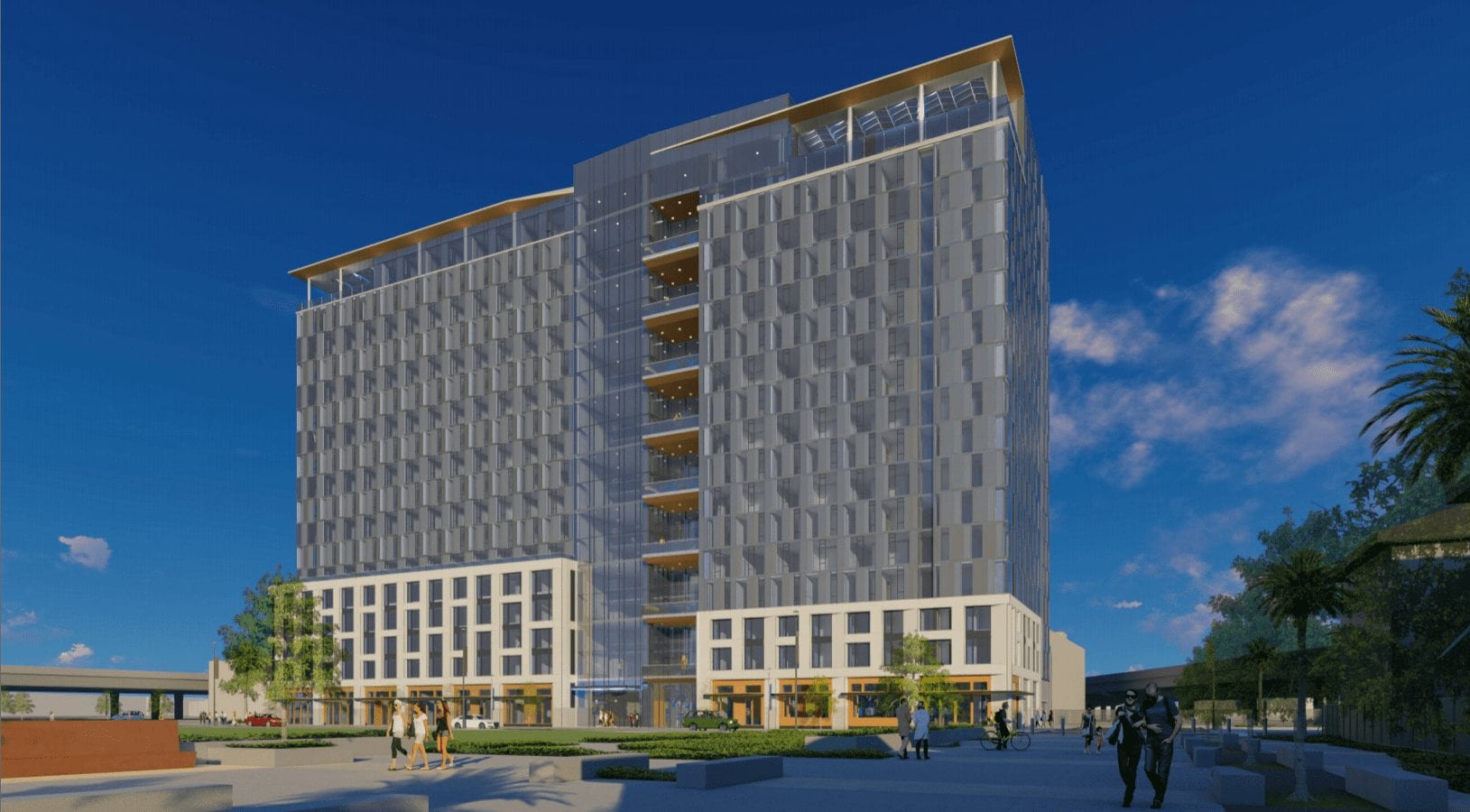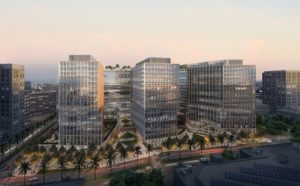San Jose is in the midst of a growth spurt that will reinvent the city’s character and reshape its skyline, having grabbed the attention and imagination of major developers and investors zeroing in on the Bay Area’s largest city with visions of big new office buildings.
But that attention comes with its own challenges in a region that is woefully short on housing. Though San Jose is one of the few cities in the Bay Area that has more homes than it does jobs — a fact that puts downward pressure on the city’s budget — it still has lofty goals to keep pace with housing needs as new office building proposals roll in.
And San Jose is already falling behind in building enough homes for the tens of thousands of new workers expected to descend upon the city.
Housing development in San Jose doesn’t seem to be on a path to rise as quickly as city leaders, residents and developers had hoped — but there’s one unexpected area that seems to have potential: co-living.
San Jose Mayor Sam Liccardo in 2017 unveiled an ambitious goal to build 25,000 new homes in the city — including 10,000 affordable units — by 2022. That means 5,000 new homes must be approved and begin rising each year between 2017 and 2022.
That isn’t happening.
“Given … the current landscape, it’s going to take every port in the storm to reach that goal,” said Blage Zelalich, San Jose’s downtown manager. “I think from our perspective we also realize that you need a variety of types of housing… The bottom line is it’s all good.”
In the areas slated for the highest densities, downtown and around Diridon Station, about 1,836 residential units are currently under construction spread across a handful of projects while another 2,556 units are approved by the city, though it is unclear when — or even if — most will start construction.
But that’s not due to lack of interest. On top of the 4,392 residential units approved or under construction in downtown, more than 3,750 residential units are currently proposed or are in the preliminary proposal stage in the downtown area, city documents show.
“Most of those units right now are stalled due to cost factors, so from a housing perspective there’s a real worry that we need to be hyper-focused on housing,” said Leslye Corsiglia, executive director for housing nonprofit SV@Home. “As we add jobs, we have to know where those people are going to live.”
So what is keeping developers from digging in?
In many cases, the residential projects aren’t “penciling,” according to Chris Neale, executive vice president at Core Cos., a San Jose-based residential developer with several developments in the city.
“Even though the profits may look large in these projects, the ‘penciling’ exercise is about what is the profit in that project, and with that, could you get a lender to lend you money to build it? And with what’s left, is there enough to attract an investor?” he said. “When that profit is too thin … they (investors) would rather put their money in another community.”
And while rents are rising, pricing people out of homes across the Bay Area, Neale said the cost to build those homes has also risen significantly, making new projects a hard sell to attract those investors — even when the rents are slated to cost thousands of dollars a month.
City leaders have heard that concern repeatedly in recent years, Zelalich said.
But even when the city approves new housing projects, there are few levers a government body can pull to encourage a developer to build in a market influenced by factors like a tight construction labor pool, the rising cost of materials and sky-high land values, she adds.
What the city can control are things like fees and taxes, zoning and processes that can make getting a permit faster or slower, and Liccardo this year vowed to look for ways to make all of those processes friendlier to developers that want to build in the city’s downtown and elsewhere.
Officials have made strides in some areas that they say will help spur development, such as raising building heights in the city’s downtown, which makes room for 8.6 million additional square feet of development in the Diridon Station area that could generate millions in annual property taxes for the city.
And while it remains to be seen whether a stalled project is propelled by more lax height limits, one step taken by the city — adding co-living to the zoning code — appears to already be spurring more home production.
For the uninitiated, co-living is a relatively new housing type that has been popping up primarily in high-cost cities around the county. It generally includes private, fully furnished bedrooms adjacent to shared spaces, including kitchens and bathrooms. The shared spaces are often stocked with household supplies by the property owner for a flat fee.
Co-living arrives in San Jose
When San Francisco-based co-living startup Starcity told San Jose leaders last year it wanted to swap an already approved traditional apartment project at 199 Bassett St. with its largest-ever co-living development, that got city officials’ attention.


The traditional residential development proposal for 304 units that had long been approved for the site at 199 Bassett St. wasn’t attracting investors that could make it come to life, according to Mark Tersini, president at KT Urban, the company behind the original apartment proposal.
Starcity wanted to buy the land and build a 800-bed co-living development, which Jon Dishotsky, co-founder and CEO of Starcity, said would attract investors — assuming city leaders would add co-living to the city’s zoning code to allow the project to forge ahead.
San Jose officials worked at what is virtually light speed when it comes to government timelines to make it happen. City leaders began public outreach in December and approved co-living in downtown two months later.
“Quite honestly it’s really good to have the private sector as our partner to bring up the innovation and that is what happened in this case,” Zelalich said.
Since then, not only has the Starcity development at 199 Bassett St. continued to move forward, but KT Urban is also reworking plans for another downtown development, known as Garden Gate at 600 S. First St., to potentially be a co-living project due to the strong investor interest in that housing type.
But despite the struggle to get traditional residential projects off the ground, Zelalich said she’s not worried the city will be overtaken by co-living developments.
“You’re always generally thinking about those kinds of things in the back of your head when you’re having conversations about different types of housing,” she said. “But really the bottom line is that, in the end, it will all kind of even out.”
Residents in downtown don’t seem too worried either.
“Obviously building housing in San Jose is a challenge for many reasons … but we need to get really creative in terms of how we look at housing,” said Bill Souders, a downtown dweller who also serves on the San Jose Downtown Residents Association board. “I think co-housing and co-living would be an excellent solution to provide a little bit of a safety valve on some of the severe demand pressure on existing housing.”
Souders and Elizabeth Chien-Hale, another resident who serves on the San Jose Downtown Residents Association board, say they live in downtown because they’ve chosen to be near transit, retail and to embrace new neighbors. Co-living in the area, they say, could become an integral part of the city’s eco-system that provides new options for middle-income residents, young people and even older homeowners looking to downsize.
“From a downtown resident perspective it is good because we are seeing retail in downtown kind of flailing,” Chien-Hale said. “I think by having more people living in the area, we should bring in more amenities for all residents.”
Indeed, San Jose, which has seen multiple false starts when it comes to development and economic booms in the past, is undergoing a transformation that could bring more retail spaces to the area.
For instance, Google is currently making plans for a 6 million- to 8 million-square-foot mixed-use mega campus near downtown, a project that has garnered plenty of attention over the past couple years.


Even sooner than that, San Francisco developer Jay Paul Co. is looking at building more than 4 million square feet of new office space in the heart of the city’s business district. Meanwhile, Gary Dillabough, a developer who has scooped up hundreds of millions of dollars worth of land in downtown, continues to buy up property slated for redevelopment.
As the city continues to draw the eye of companies and developers, major office proposals are spiking anxieties among some residents who fear that without enough housing, new office buildings will cause displacement of vulnerable communities.
But Neale says those commercial developments may not be a bad thing for housing.
“We, the housing developers, need the office developers, and they also need us,” he said, noting that in the past San Jose has been primarily eyed for housing projects over office space. “To me that is what is a little different right now: there’s an interest and market for both of them, so that gives me hope.”
Contact Janice Bitters at [email protected] or follow @JaniceBitters on Twitter.



Leave a Reply
You must be logged in to post a comment.